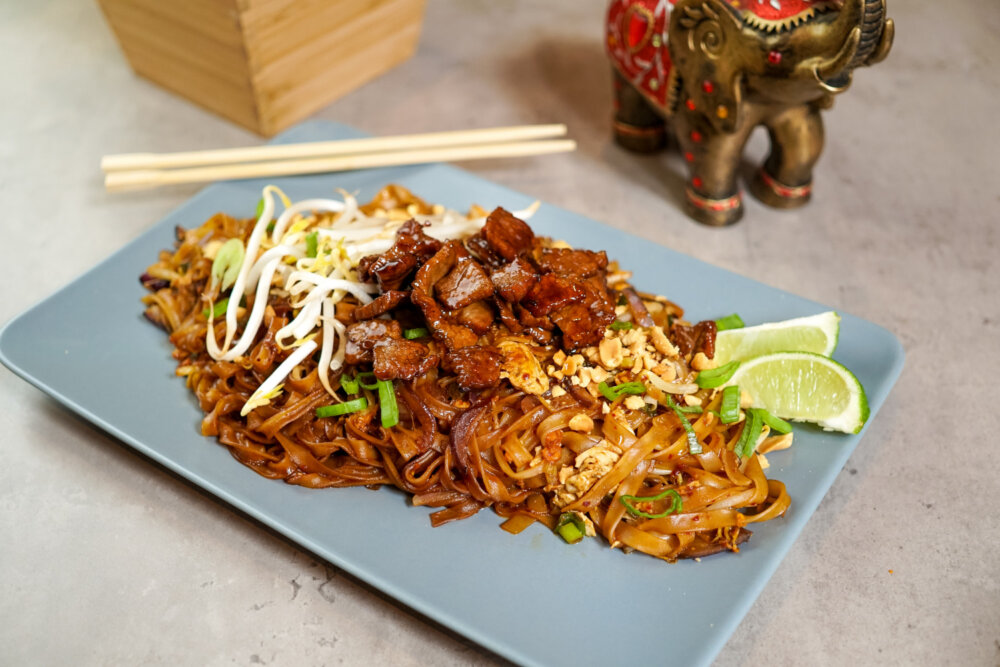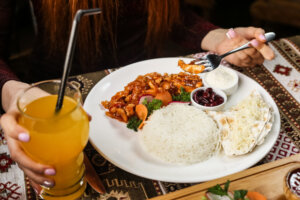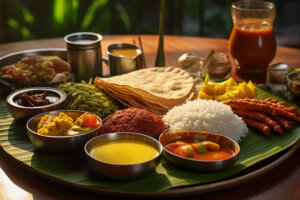Introduction
Listen closely on a Sri Lankan evening and you’ll hear it before you smell it: a rapid metallic tattoo of blades on iron. Tak-tak-tak—pause—tak-tak-tak. It’s the rhythm of the kottu master, and for many of us, it’s the heartbeat of the island after dark. Steam rises from a flat griddle, smelling of curry leaves, green chili, and toasted flour. Tuk-tuks idle at the curb while friends lean against counters, talking cricket, politics, and family news. This is where strangers become neighbors, where a simple dish called Kottu Roti turns night into a shared memory.
I grew up chasing that sound. My mother would send me for a parcel on rainy nights, and I’d watch, mesmerized, as the cook chopped roti into ribbons, folding in leftover curry and crackling egg. The first bite always tasted like warmth after a storm: tangy lime, gentle heat, and the comforting chew of roti soaking in spice. Kottu Roti isn’t just Sri Lankan street food. It’s a story told with steel and fire, with humor and hustle, with enough aroma to pull you into the light of a roadside “kade” (eatery) when you least expect it.
A Taste of History
The exact birthplace of Kottu Roti isn’t written in stone; like many good stories, it travels by word of mouth. Some elders in the eastern towns—Batticaloa and Trincomalee—say it emerged in Tamil Muslim eateries, where cooks chopped day-old godamba roti to stretch a pot of curry into something filling and fast. Others remember the late 1970s and 80s, when tight wallets and long nights encouraged thrift and creativity, and kade cooks began to turn leftovers into a symphony of spice on iron.
There’s another tale too: that Kottu Roti blossomed under curfews and early closings, when hungry travelers and night workers needed food that could be made quickly, customized easily, and eaten standing up. Whatever the spark, the flames caught across the island. From Jaffna to Galle, cooks folded community into the dish—beef or mutton in some neighborhoods, seafood along the coast, vegetable and egg kottu where diners preferred meat-free meals. In every version, the central idea remained: make something generous from what you have, feed people well, and do it with flair.
Ingredients or Key Elements
While Kottu Roti welcomes endless variations, a few essentials define its soul:
- Godamba roti: A soft, flaky, paratha-like flatbread, chopped into small pieces that drink up spice and gravy.
- A curry base: Chicken, beef, mutton, seafood, egg, or vegetables—plus a ladle of fragrant gravy to bind it all.
- Aromatics and veg: Onion, leeks, carrots, cabbage, green chilies, and occasionally tomatoes or spring onions.
- Eggs (optional): Smashed and scrambled straight onto the hot iron for body and richness.
- Spice and lift: Curry leaves, mustard seeds, turmeric, chili powders, black pepper, and a squeeze of lime.
- Fat for flavor: Coconut oil or ghee, shimmering on the griddle and perfuming the night air.
- The tools and the stage: A flat iron griddle and two blunt metal blades. And, of course, the kade counter where the cook becomes part drummer, part storyteller.
Beyond ingredients, there are cultural elements too: the easy banter, the trust in the cook’s hands, the quick smile when you ask for “extra gravy,” and the simple fact that Kottu Roti belongs to everyone—students, night-shift workers, families, and travelers who wander in with curiosity and leave a little more local than they arrived.
Preparation or Practice
It begins with heat. The iron griddle warms until a sheen of coconut oil ripples like monsoon rain on a lake. The cook tosses in chopped onions; they hiss, then sweeten, their edges catching gold. Curry leaves snap in the oil, popping tiny fireworks of scent. A handful of green chilies brings a sharp, grassy aroma that makes you blink with anticipation.
Next, the roti. Stacked and soft, it’s chopped into bite-sized strips. The blades rise and fall in a staccato rhythm as the cook pulls the pieces into a neat mound. Vegetables tumble in—thinly sliced leeks, slivered cabbage, coins of carrot—stirring color into the pale roti. If you’ve asked for egg, it pops onto the griddle, flicked into a soft scramble that wraps around the roti like a silk shawl.
Then comes the heart: a ladle of curry and a spoon of gravy. This is where a simple stir-fry becomes Kottu Roti—moist, fragrant, and resonant with whatever protein or veg you’ve chosen. The cook chops and folds, chops and folds, tasting with eyes and ears as much as with tongue. A dusting of chili powder warms the back of your throat; pepper sparks; turmeric glows like late sunlight. A squeeze of lime brightens everything, and a final tap-tap of the blades calls you to the counter.
In a minute or two, it’s ready. The parcel is heavy in your hand, hot through the paper, promising comfort. You taste it and the whole street comes into focus: laughter, steam, the tang of metal, and the soft chew of roti carrying the memory of spice.
Symbolism or Local Meaning
Kottu Roti is the island in a single pan—layered, adaptable, and full of conversation. It’s a dish that refuses to stand still, blending Tamil, Sinhala, Muslim, and Burgher influences without ceremony. In its chop-and-mix you can hear city music and village rhythm; in its thrift you can taste resilience; in its spice you feel the energy of a people who make joy out of everyday moments.
For many, it’s comfort food—the late-night friend after a long bus ride, the quick feast on a study break, the reward after a match under floodlights. For others, it’s a taste of home in a changing world: a dish that stays accessible, customizable, and welcoming, whether you prefer vegetarian, halal, or extra-cheesy indulgence. Most of all, Kottu Roti is a reminder that our best stories are communal. We stand together at the counter and watch a small performance, and then we eat the applause.
Where to Experience It
Colombo’s Night Heartbeat
Start where the city never sleeps. In Kollupitiya and Bambalapitiya, iconic kades like Pilawoos serve famous cheese kottu late into the night. In Pettah’s market streets, family-run spots stir up classic chicken or egg kottu for office workers and porters alike. Evening walks along Galle Face Green reveal portable griddles perfuming the sea breeze—simple, bustling, and irresistibly local.
Kandy’s Market Buzz
Near the central market and around Peradeniya Road, you’ll find kottu stations that spark to life after sunset—popular with students and families. The hill air makes the steam feel extra comforting, and the gentler spice balances beautifully with a squeeze of lime.
Jaffna and the East
In Jaffna town, stalls near major junctions serve versions rich with onion, curry leaf, and sometimes a northern-style mutton curry gravy. Along the east, from Trincomalee to Batticaloa and Kalmunai, you’ll encounter kottu with coastal flair—seafood options, generous gravies, and a confident hand with spice.
The South and the Surf
Galle, Matara, Hikkaduwa, and Arugam Bay bring beach-town personality to Kottu Roti. After a day in the waves, nothing beats the sizzle of a roadside griddle. Expect laid-back counters, backpackers trading tips, and cooks who’ll happily tweak the heat to your comfort.
Hill Country Comfort
Ella’s main street is a parade of sizzling griddles past sundown. In Nuwara Eliya, where evenings turn cool, a hot kottu parcel feels like a woolen shawl for your appetite—rich, warming, and soothing after a tea estate hike.
Upmarket Takes
Many hotel buffets and village-themed restaurants in Colombo and major towns host live kottu stations—think places like Nuga Gama-style venues—where you can watch the craft in comfort, with consistent hygiene and a broad range of options.
Tips for Travelers
- Follow the sound and the crowd: Busy kades turn over ingredients quickly and usually deliver the freshest flavors.
- Choose your spice: Ask for mild, medium, or hot. If needed, “less spicy, please” is understood. A squeeze of lime cuts heat if you overestimate your tolerance.
- Pick your style: Classic chicken or egg kottu is widely loved. Vegetarian and vegan versions (without egg) are common; cheese kottu is indulgent comfort. Seafood is great in coastal towns.
- Mind the space: Enjoy the show, but stand back from the griddle so the cook can work safely and swiftly.
- Gravy matters: Ask for a little extra curry gravy on the side to moisten leftovers or enhance the last bites.
- Hygiene cues: Look for hot, sizzling griddles, clean chopping blades, and ingredients kept covered. Trust your senses.
- Payment: Small notes are convenient. Many kades are cash-first, though some urban spots accept cards or digital wallets.
- Ask and learn: Cooks are usually happy to explain. A friendly “istuti” (thank you in Sinhala) or “nandri” (thank you in Tamil) goes a long way.
- Be sustainable: Eat in when you can, or request paper over plastic for take-away. Carry a reusable bottle to cut waste.
Conclusion
In Sri Lanka, the night has a flavor. It’s the warmth that rises from a griddle, the generous slap of roti on iron, the dance of curry leaves in hot oil. Kottu Roti gathers people into its circle—drivers on break, friends on a stroll, families celebrating the small victories of ordinary days. Each chop of the blade keeps time with a city’s breath; each forkful retells a story of ingenuity, welcome, and spice.
When you finally sit down with your plate—steam fogging your glasses, lime shining on your fingers—you’ll taste more than dinner. You’ll taste the island’s talent for turning scarcity into abundance, for blending differences into harmony, for making a humble meal feel like a festival. That’s the story of Kottu Roti: born from many hands, perfected by night, and waiting for you at the counter, just as the blades begin their song.




